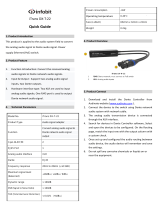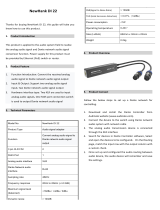
Attero Tech by QSC unHX2D
User Manual
QSC, LLC 2020 614-00038
3 – Device Configuration
There are two parts of the device that require software to setup. First are the configurable features of the device and
second is the Dante™/AES67 audio routing.
Configuration of the unHX2D specific features is carried out using the Attero Tech unIFY Control Panel application. This
application is available from the Attero Tech website (www.atterotech.com
). It should be used to examine and modify the
device specific features such as input sensitivity and internal audio source routing.
If the Dante™/AES67 audio is used, the audio routing should be carried out using any application that supports
Dante™/AES67 audio routing. This could be from a 3
rd
party manufacturer or Audinate’s own Dante™ Controller. Dante™
Controller can be obtained from the Audinate website (www.Audinate.com
). Instructions on how to use this software and
about setting up routes on a Dante network can also be found on Audinate’s website.
*Note: When using Dante™ Controller, the unHX2D will be shown using a default device name of unHX2D-###### where
‘######’ is the last six characters of the device’s MAC address.
3.1 – IP Address Setup
******************************************************* IMPORTANT ******************************************************
Failure to correctly configure an IP address will not allow an unHX2D device to correctly authenticate in the unIFY Control
Panel software and while it will be detected by Dante Controller, it will not appear in the routing table. It will be visible on
the “Device Info” page, though only its name will present and all other information will be blank. Other information on
the unHX2D in other parts of Dante Controller will also either be blank or marked “N/A”. In this state, it will also not be
possible to route audio to and from the unHX2D either.
In order to configure an unHX2D both to set up its internal parameters and also setup audio routing, the PC will need to
be able to communicate with it over the network. While all Dante devices will be discovered regardless of the IP address
setup on the PC, communication can only occur if the PC and the device have compatible IP addresses.
By default, the unHX2D is set to get a dynamic IP address. As with all Dante™/AES67 devices, if the unHX2D device does
not find a DHCP server to retrieve an IP address from, it will give itself a local link address sometimes also known as an
automatic private IP address (APIPA) instead. A local link address is always in the range 169.254.x.y.
To ensure communication, the PC can either be set to get a dynamic IP address or be given a static IP address in the range
169.254.x.y. The PC may require a restart for the changes to its IP address setup to take effect.
Further information on IP setup for an audio system using Dante™/AES67 can be found in the FAQ’s on Audinate’s website
(https://www.audinate.com/resources/faqs
).
3.2 – Factory Reset
******************************************************* IMPORTANT ******************************************************
The factory reset returns the entire device to its factory defaults. Using this feature will mean all custom Dante™/AES67
settings and all audio power-on default settings will be cleared.
*NOTE: The factory reset is a useful way of quickly restoring communications with a device which has an unknown static
IP address as a factory reset returns the device’s network settings to getting a dynamic IP. Having successfully completed
a factory reset of the device, setting the PC’s IP address to also obtain a dynamic IP address should then allow the PC to
communicate fully with that device.
The factory reset button is accessed through a small hole on the front of the unit using a small screwdriver or a paperclip.
A factory reset is initiated by pressing and holding this button for 5 seconds or more while the device is running and then
releasing it. If done correctly, the Dante status LEDs will change state. They will all turn off except for the “SYS” LED which
will turn red for a couple of seconds. All three LEDs will then briefly turn orange, before the device then reboots and a
normal start-up procedure begins. If the LEDs remain green immediately after releasing the button, that is an indication
the button was not held for long enough and the factory reset was not applied.
Having applied a successful factory reset, on the Dante side, customized device name and channel names will be cleared
and any receive flow subscriptions will be removed. The network settings will also be reset so the device will return to
retrieving an IP address dynamically. The power-up defaults for the audio settings are also cleared. For every input, input
gain is set back to 0dB while the input pad and phantom power settings are turned off. For every output, output volume
is set to maximum (0dB) and the output mute is disabled.




















